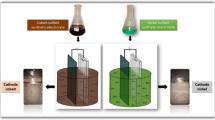Abstract
The use of a Pt catalysed H2-diffusion anode for Ni electrowinning has been studied from typical chloride, Watts and sulfate baths at 25 °C. Higher anodic current densities are found in a three-electrode cell when sulfate ions are gradually replaced by chloride ions. Adherent Ni deposits are obtained from the Watts and sulfate media, whereas in the chloride bath, Cl2 is released at the anode and less adherent deposits are formed. Current efficiencies between 94 and 98 for anodic current densities ranging from 15 to 65 mA cm-2 have been found. The energy costs for Ni electrowinning decrease with increasing chloride content in the bath, and their values are always much lower than those reported using conventional DSA, graphite or lead anodes. All deposits are composed of high-purity Ni, free of heavy metals and other impurities. The crystals have a face-centred cubic structure with a preferential orientation which mainly depends on the medium and current density. A superimposed magnetic field of 0.9 T orientated either parallel or perpendicular to electrodes in a two-electrode cell exerts only a small effect on the crystallographic orientation of Ni, although it has a certain influence on its morphology.
Similar content being viewed by others
References
D.J. Mackinnon, ‘The Electrowinning of Metals from Aqueous Chloride’ in (ed. by K. Osseo-Asare and J.D. Miller), Conference Proceedings of the Metallurgical Society of AIME, Hydrometallurgy Research, Development and Plant Practice (New York, 1982), p. 659.
E. Jackson, ‘Hydrometallurgical Extraction and Reclamation’ (Horwood, Chichester, 1986), p. 221.
Ullmann's, ‘Encyclopedia of Industrial Chemistry’, 5th edn, Vol. A17 (VCH, Weinheim, 1994), p. 189.
J.P. Hoare, J. Electrochem. Soc. 133 (1986) 2491.
J. Ji, W.C. Cooper, D.B. Dreisinger and E. Peters, J. Appl. Electrochem. 25 (1995) 642.
E. Küzeci, R. Kammel and S.K. Gogia, J. Appl. Electrochem. 24 (1994) 730.
V. Nikolova, T. Nikolov, T. Vitanov, A. Möbius, K. Wiesener and D. Schab, J. Appl. Electrochem. 21 (1991) 313.
B.C. Banerjee and A. Goswami, J. Electrochem. Soc. 106 (1959) 20 and 590.
A. Chiba, K. Kitamura and T. Ogawa, Surf. Coat. Technol. 27 (1986) 83.
C. Kollia, N. Spyrellis, J. Amblard, M. Froment and G. Maurin, J. Appl. Electrochem. 20 (1990) 1025.
C. Kollia and N. Spyrellis, Surf. Coat. Technol. 57 (1993) 71.
A.M. El-Sherik, U. Erb and J. Page, Surf. Coat. Technol. 88 (1996) 70.
L. Yang, J. Electrochem. Soc. 101 (1954) 456.
A.L. Danilyuk, V.I. Kurmashev and A.L. Matyushkov, Thin Solid Films 189 (1990) 247.
R.A. Tacken and L.J.J. Janssen, J. Appl. Electrochem. 25 (1995) 1.
O. Devos, A. Olivier, J.P. Chopart, O. Aaboubi and G. Maurin, J. Electrochem. Soc. 145 (1998) 401.
A. Hamnett, P.S. Stevens and R.D. Wingate, J. Appl. Electrochem. 21 (1991) 982.
E. Brillas, R.M. Bastida, E. Llosa and J. Casado, J. Electrochem. Soc. 142 (1995) 1733.
Author information
Authors and Affiliations
Rights and permissions
About this article
Cite this article
Brillas, E., Rambla, J. & Casado, J. Nickel electrowinning using a Pt catalysed hydrogen-diffusion anode. Part I: Effect of chloride and sulfate ions and a magnetic field. Journal of Applied Electrochemistry 29, 1367–1376 (1999). https://doi.org/10.1023/A:1003852924383
Issue Date:
DOI: https://doi.org/10.1023/A:1003852924383




